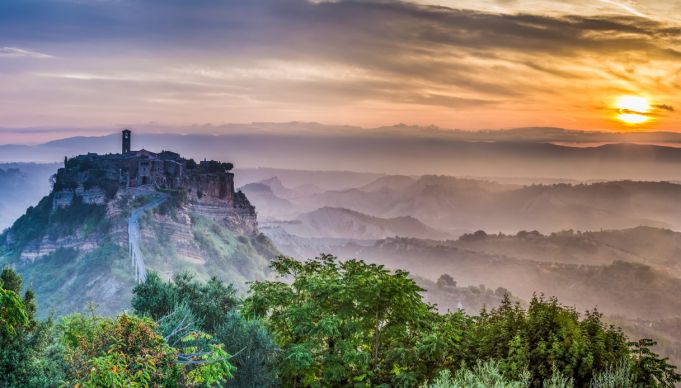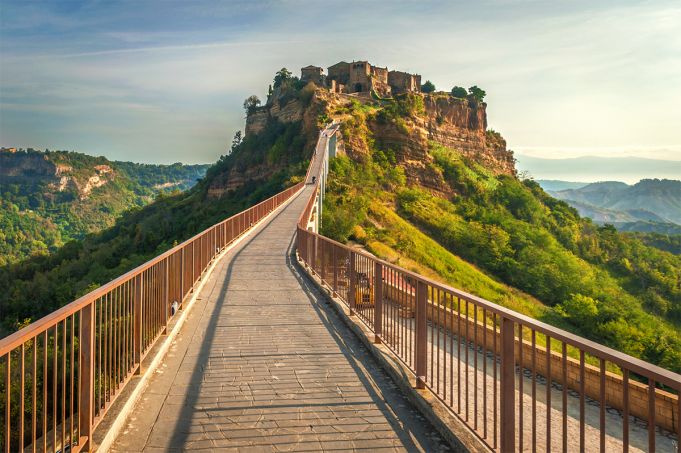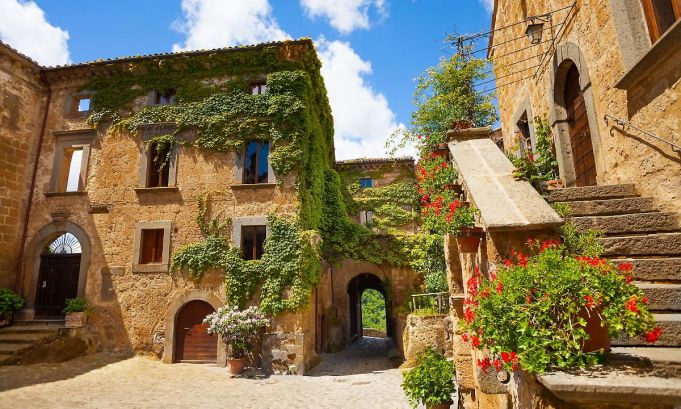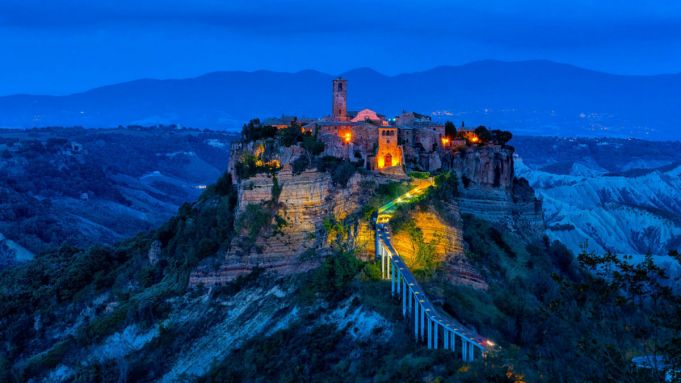Efforts to save the north Lazio town of Civita di Bagnoregio have been in place for centuries but have intensified in recent years.
The spectacular mediaeval hilltop town of Civita di Bagnoregio, known as the "castle in the sky", is located in the province of Viterbo, 110km north of Rome.
Perched on exceptionally unsound foundations, the hamlet has gradually been reduced in size due to centuries of earthquakes and landslides which have chipped away at its soft volcanic base.
The original town centre remains intact, however, surging out of the desolate Calanchi valley whose chasms and chalky cliffs resemble a mini-Grand Canyon.
Christened La città che muore by the Civita-born writer Bonaventura Tecchi, this “dying town” has long been condemned by authorities over fears that its collapse into the valley is not only probable but inevitable. Today the town's community has dwindled to just 12 permanent residents, although that number increases to around 100 during the summer months.

In 2015 the Lazio region's governor Nicola Zingaretti launched an appeal, calling on UNESCO to recognise Civita as a World Heritage Site. Zingaretti stated that Civita is “now in extreme and urgent need of maintenance unless we wish to deprive ourselves forever of a sentinel of our cultural history, a piece of our heritage.”
The Lazio Region also injected €1.2 million in shoring up the town’s shaky foundations to protect it from the erosion that “threatens its very survival.”
In September 2019 the region's campaign resulted in Civita becoming an official candidate in the prestigious UNESCO listing. If successful, its world heritage classification would ensure a steady flow of conservation funding for Civita.
Saving Civita
The concept of saving Civita, however, predates Zingaretti’s appeal by several centuries. Records show that the townspeople were taking precautions as far back as 1373 when the digging of caves was banned, along with grazing beneath the town’s cliffs, whose bedrock comprises a 60-m thick layer of tufa over an unstable base of clay and sand.
Local church authorities saw the writing on the wall by 1699, transferring their diocesan base to Bagnoregio, followed by a mass evacuation of residents in 1819.
More recently, the town in 1988 saw the birth of the Associazione Progetto Civita, an association of public and private institutions that has grown into a major cultural force, organising exhibitions in Italy as well as helping to promote the conservation of Civita itself.
Over the last five years, geologists have drilled horizontal steel rods or “anchors” deep into the valley floor, which in turn are attached to plates on the cliff face, as well as filling cracks and emptying recesses of water.
History of Civita di Bagnoregio
The town is about 1,200 years old but its origins date back to the sixth century BC and the Etruscans, whose caves can still be visited. Although Stone Age artefacts have been discovered in the area, there are no human traces from the subsequent Bronze Age.
Experts believe this is due to the frequent volcanic activity in the surrounding region around Monti Volsini – a minor mountain range in north Lazio – which led to the formation of the crater we know today as Lake Bolsena.

Between the fifth and eighth centuries, Civita was almost continually subjected to siege, changing hands numerous times. It was first occupied by the Goths, then the Byzantines, followed by the Lombards, before becoming part of the Papal States in 774.
It is also the home of the Franciscan saint Bonaventure, considered one of the greatest philosophers of the Middle Ages, whose birthplace and monastery seem to have disappeared into thin air.
Civita today
Modern-day Civita is not easy to reach, particularly by public transport, but like all good things it is well worth the effort. To access the town visitors must make their way over a narrow, steep footbridge, which is 275-m long and is suspended at great height.
There is a €5 charge to cross the valley, payable on the Bagnoregio side, and it is not uncommon to see less courageous people being led across with their eyes closed. Built in 1965, the concrete structure replaced a temporary wooden version constructed after German troops blew up the existing masonry bridge in 1944.
Those in the tourism business wax lyrical about Civita, and it is easy to see why. It is beyond idyllic. The first glimpse of the town from the viewing point across the valley is jaw-dropping.
Hydrangeas and geraniums tumble over its meticulously-kept stone footpaths; the lunchtime hum of conversation and clinking cutlery is offset by the cicada buzz rising from the valley below.
Civita in film
Its beauty has caught the imagination of artists and filmmakers, notably Japan’s Hayao Miyazaki, who drew inspiration from Civita for his 1986 animated movie Laputa: Castle in the Sky, and Italy's Alberto Sironi, who chose the hilltop town as the setting for his 2009 film Pinocchio, starring Bob Hoskins.

The official travel guidebook uses effusive terms to describe Civita, “surrounded in a fog of unreality” as if “an island in our memory or a figment of our imagination.” However despite Civita being promoted as the “hidden pearl in the heart of Lazio”, the reality is that the town’s supposedly secret status is long gone. One senses that visiting the place a couple of decades ago may have been more of an adventure.
Civita has successfully branded itself, making much of its locally produced food and wine, and even has its own craft beer label. A sign on the door of Trattoria Antica Forno states: “The Rick Steves readers are welcome!” while the people behind the Acqua di Civita range of perfumes and soap boast of international sales and requests to launch their products in London and Tehran.
Neither is Civita unique among northern Lazio “ghost towns” condemned for safety reasons – Calcata being the most obvious comparison. Like Calcata, Civita has no cars, post office, supermarket or pharmacy. However, unlike Calcata, which is relatively down-at-heel, Civita is twee and manicured, offering picture-postcard material at every turn. It also has the slick stamp of marketing all over it.

The town’s unpaved main square, Piazza S. Donato, until the 1960s catered for a large circular olive oil press, operated by donkeys. These days the animals still make an appearance in the piazza for the traditional donkey race, known as the tonna, a popular spectacle held in June and September each year.
The piazza is also home to the S. Donato church, founded in the eighth century on a pre-existing Roman temple. Its walls are dotted with shrines and reliquaries, including a gold and silver arm containing bones of S. Bonaventura.
Tourism
Based at the deli-bar Magna Civita, located on the edge of Bagnoregio before the viewing point and bridge, Valerio Simplicio is well placed to observe Civita’s tourists. “There has been a surge of tourism in recent years, with a large number of international visitors, particularly from Asia,” he says. “The tourist season is all year round but spring is the busiest time.”
So while Civita may be dying from a geological perspective, locals are embracing the tourists keen to visit the embattled town which, for now, refuses to go gently into that good night.
By Andy Devane
Getting there
The best way to reach Bagnoregio from Rome is to make the roughly 1.5-hour journey by car, taking the Orvieto exit off the A1 motorway.
Trains depart from Roma Termini to Orvieto whose station is connected to Bagnoregio by Cotral bus. It is also possible to reach Bagnoregio by Cotral bus from Viterbo Porta Fiorentina (train from Roma Ostiense) but the Orvieto option is less complicated.
The coaches are not very regular so check times before travelling. Orvieto is 20km away from Bagnoregio, Viterbo 30km, but both bus trips take about an hour.
Useful contacts
Comune di Bagnoregio www.comune.bagnoregio.vt.it
Cotral bus www.cotralspa.it
Associazione Progetto Civita www.civita.it
General Info
View on Map
Civita di Bagnoregio: Lazio town that refuses to die
01022 Civita di Bagnoregio, VT, Italy




















